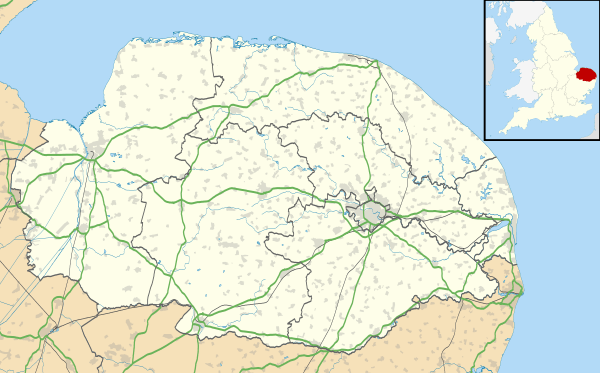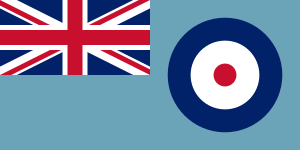RAF Weybourne
RAF Weybourne was a Second World War anti-aircraft establishment. 'X' Flt, No 1 Anti-Aircraft Co-operation Unit were based at the station between 16 May and 14 September 1939, with 'T' Flt, No 1 Anti-Aircraft Co-operation Unit there between 25 February and 29 April 1942. No 6 Anti-Aircraft Co-operation Unit were based there between 7 December 1942 and 30 November 1943.[2]
| RAF Weybourne | |||||||||
|---|---|---|---|---|---|---|---|---|---|
| Norwich, Norfolk in England | |||||||||
.jpg) Weybourne airfield in 2012 | |||||||||
 RAF Weybourne Shown within Norfolk | |||||||||
| Coordinates | 52.9505°N 1.1215°E | ||||||||
| Site information | |||||||||
| Owner | Air Ministry | ||||||||
| Operator | Royal Air Force | ||||||||
| Site history | |||||||||
| Built | 1939 | ||||||||
| In use | 1939-1942[1] | ||||||||
| Airfield information | |||||||||
| |||||||||
Associated with the anti-aircraft gunnery, the station operated the De Havilland DH-82B Queen Bee target drone aircraft, a radio-controlled target tug version of the Tiger Moth II.
Postwar
Although the published closure date known for this airfield relates to the World War II airfield, the Army maintained an Anti Aircraft training camp across from RAF Weybourne using Bofors 40 mm guns linked to AA4 mk7 gun-laying radar. When that closed in 1958 the radars were transferred to the RAF. A very small permanent detachment was maintained there using the obsolete radar into the 1980s for cross-tell training, decoy work and to extend low level coverage. In the late 1980s trials were carried out to confirm the site's suitability for deployment of the new mobile radars that were coming into service.
A Marconi Type 91 'Martello' radar was moved from RAF Trimingham to Weybourne in September 1996, operated by 432 Signals Unit acting as a Ready Platform (along with RAF Hopton and Trimingham) for the IUKADGE Series II (United Kingdom Air Defence Ground Environment) Radar System controlled from the R3 underground control centre at RAF Neatishead.
In October 1997 the Type 91 at RAF Weybourne was de-built; replaced when the Type 93 at RAF Trimingham became operational.[3]
In 2001 the station was used during an exercise by 22 Squadron RAF Search & Rescue, suggesting that it was still technically active at that time.
The old camp was until recently used occasionally by the Boy Scouts as a camp site. Ironically one of the ancient AA4 Mk7 radars that had been transferred from the army camp in 1958 was moved back where it came from to join the Muckleburgh Collection shortly after the RAF put the site back into 'care and maintenance'
See also
| Wikimedia Commons has media related to Royal Air Force. |
| Wikimedia Commons has media related to Aircraft of the air force of the United Kingdom. |
- Royal Air Force station
- List of former Royal Air Force stations
- List of Royal Air Force aircraft squadrons
References
- "Weybourne". Airfields of Britain Conservation Trust. Retrieved 14 April 2020.
- RAF Web: Stations W
- A History Of Royal Air Force Neatishead
